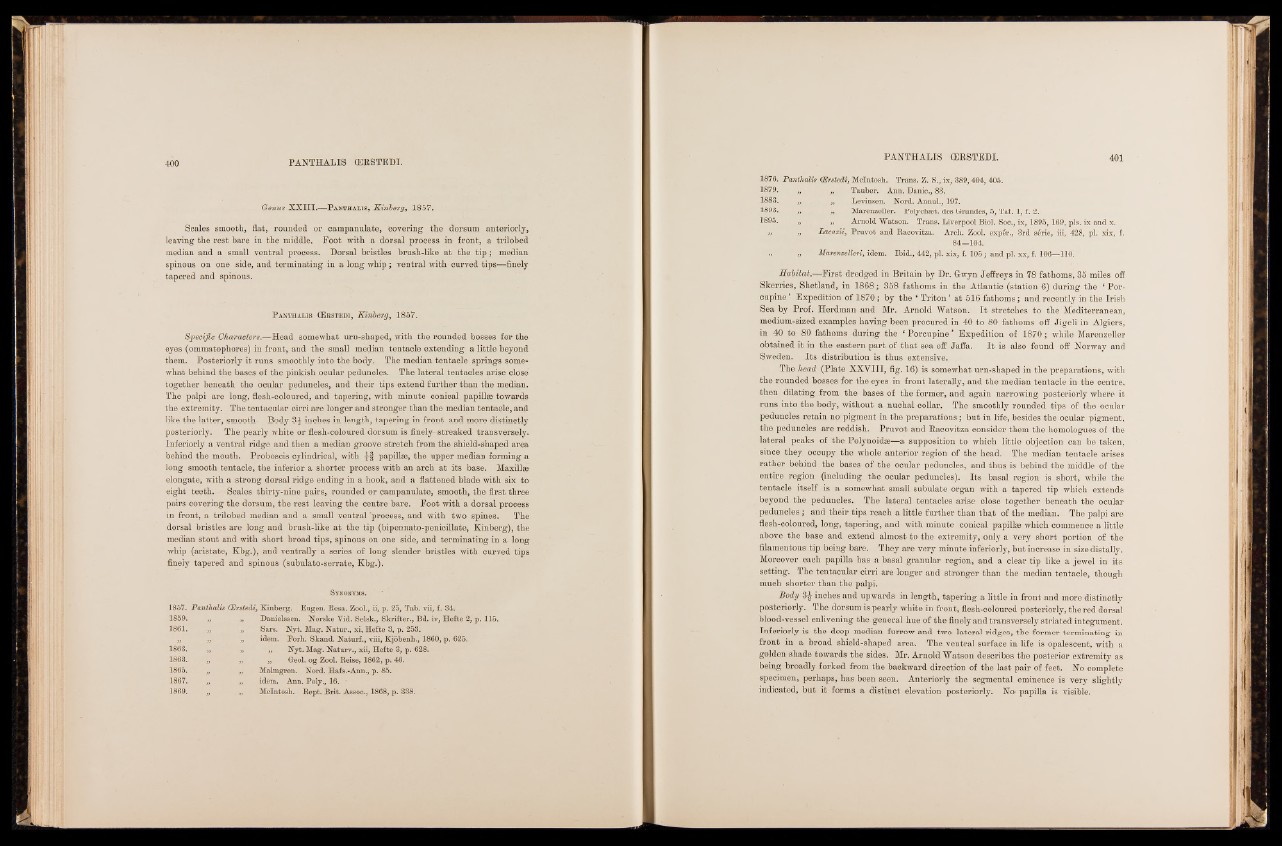
Genus XXIII.—Panthalis, Kinberg, 1857.
Scales smooth, flat, rounded or campanulate, covering the dorsum anteriorly,
leaving the rest bare in the middle. Foot with a dorsal process in front, a trilobed
median and a small ventral process. Dorsal bristles brush-like at the tip ; median
spinous on one side, and terminating in a long whip; ventral with curved tips—finely
tapered and spinous.
Panthalis (Ebstkdi, Kinberg, 1857.
Specific Characters.—Head somewhat urn-shaped, with the rounded bosses for the
eyes (ommatophores) in front, and the small median tentacle extending a little beyond
them. Posteriorly it runs smoothly into the body. The median tentacle springs somewhat
behind the bases of the pinkish ocular peduncles. The lateral tentacles arise close
together beneath the ocular peduncles, and their tips extend further than the median.
The palpi are long, flesh-coloured, and tapering, with minute conical papillae towards
the extremity. The tentacular cirri are longer and stronger than the median tentacle, and
like the latter, smooth. Body 8£ inches in length, tapering in front and more distinctly
posteriorly. The pearly white or flesh-coloured dorsum is finely-streaked transversely.
Interiorly a ventral ridge and then a median groove stretch from the shield-shaped area
behind the mouth. Proboscis cylindrical, with y§ papillae, the upper median forming a
long smooth tentacle, the inferior a shorter process with an arch at its base. Maxillae
elongate, with a strong dorsal ridge ending in a hook, and a flattened blade with six to
eight teeth. Scales thirty-nine pairs, rounded or Campanulate, smooth, the first three
pairs covering the dorsum, the rest leaving the centre bare. Foot with a dorsal process
in front, a trilobed median and a small ventral “process, and with two spines. The
dorsal bristles are long and brush-like at the tip (bipennato-penicillate, Kinberg), the
median stout and with short broad tips, spinous on one side, and terminating in a long
whip (aristate, Kbg.), and ventrally a series of long slender bristles with curved tips
finely tapered and spinous (subulato-serrate, Kbg.).
S ynonyms.
1857. Panthalis GErstedi, Kinberg. Eugen. Resa. Zool., ii, p. 25, Tab. vii, f. 34.
1859. „
1861.
1863.
1863..
1865.
1867.
1869.
Danielssen. Norske Vid. Selsk., Skrifter., Bd. iv, Hefte 2, p. 115
Sars. Nyt. Mag. Natur., xi, Hefte 3, p. 253.
idem. Forh. Skand. Naturf., viii, Kjöbenh., 1860, p. 625.
„ Nyt. Mag. Naturv., xii, Hefte 3, p. 628.
„ Geol. og Zool. Reise, 1862, p. 46.
Malmgren. Nord. Hafs.-Ann., p. 85.
idem. Ann. Poly., 16. •
McIntosh. Rept. Brit. Assoc., 1868, p. 338.
PANTHALIS OERSTEDI. 401
1876. Pa/nthalis GErstedi, McIntosh. Trans. Z. S., ix, 389,404, 405.
1879. ,, „ Tauber. Ann. Danic., 83.
1883. „ . „ Levinsen. Nord. Annul., 197.
1893. ,', „ Marenzeller. Polychæt. des Grandes, 5, Taf. 1, f. 2.
1895. „ „ Arnold Watson. Trans. Liverpool Biol. Soc., ix, 1895, 169, pis. ix and x.
» » LacazU, Pruvot and Racovitza. Arch. Zool. expér., 3rd série, iii, 428, pi. xix, f.
84—104.
» „ Marenzelleri, idem. Ibid., 442, pi. xix, f. 105 ; and pi. xx, f. 106—110.
Habitat.—First dredged in Britain by Dr. G-wyn Jeffreys in 78 fathoms, 35 miles off
Skerries, Shetland, in 1868; 358 fathoms in the Atlantic (station 6) during the ‘ Porcupine
’ Expedition of 1870; by the ‘ Triton * at 516 fathoms; and recently in the Irish
Sea by Prof. Herdman and Mr. Arnold Watson. I t stretches to the Mediterranean,
medium-sized examples having been procured in 40 to 80 fathoms off Jigeli in Algiers,
in 40 to 80 fathoms during the * Porcupine * Expedition of 1870; while Marenzeller
obtained it in the eastern part of that sea off Jaffa. I t is also found off Norway and
Sweden. Its distribution is thus extensive.
The head (Plate XXVIII, fig. 16) is somewhat urn-shaped in the preparations, with
the rounded bosses for the eyes in front laterally, and the median tentacle in the centre,
then dilating from the bases of the former, and again narrowing posteriorly where it
runs into the body, without a nuchal collar. The smoothly rounded tips of the ocular
peduncles retain no pigment in the preparations; but in life, besides the ocular pigment,
the peduncles are reddish. Pruvot and Racovitza consider them the homologues of the
lateral peaks of the Polynoidge—a supposition to which little objection can be taken,
since they occupy the whole anterior region of the head. The median tentacle arises
rather behind the bases of the ocular peduncles, and thus is behind the middle of the
entire region (including the ocular peduncles). Its basal region is short, while the
tentacle itself is a somewhat small subulate organ with a tapered tip which extends
beyond the peduncles. The lateral tentacles arise close together beneath the ocular
peduncles ; and their tips reach a little further than that of the median. The palpi are
flesh-coloured, long, tapering, and with minute conical papillse which commence a little
above the base and extend almost to the extremity, only a very short portion of the
filamentous tip being bare. They are very minute inferiorly, but increase in size distally.
Moreover each papilla has a basal granular region, and a clear tip like a jewel in its
setting. The tentacular cirri are longer and stronger than the median tentacle, though
much shorter than the palpi.
Body 3£ inches and upwards in length, tapering a little in front and more distinctly
posteriorly. The dorsum is pearly white in front, flesh-coloured posteriorly, the red dorsal
blood-vessel enlivening the general hue of the finely and transversely striated integument.
Inferiorly is the deep median furrow and two lateral ridges, the former terminating in
front in a broad shield-shaped area. The ventral surface in life is opalescent, with a
golden shade towards the sides. Mr. Arnold Watson describes the posterior extremity as
being broadly forked from the backward direction of the last pair of feet. No complete
specimen, perhaps, has been seen. Anteriorly the segmental eminence is very slightly
indicated, but it forms a distinct elevation posteriorly. No> papilla is visible.